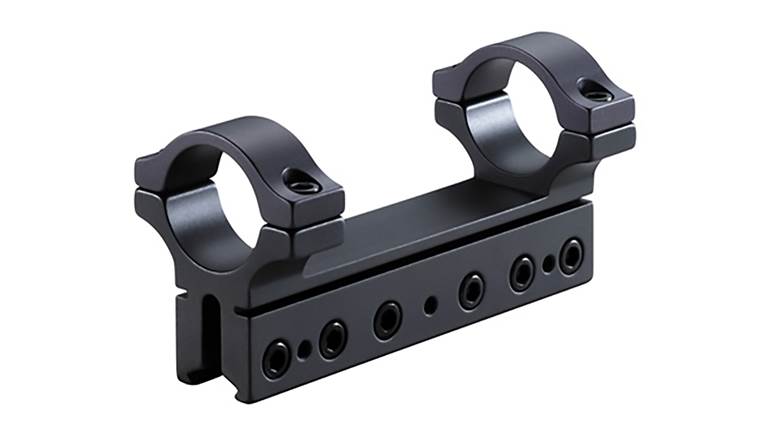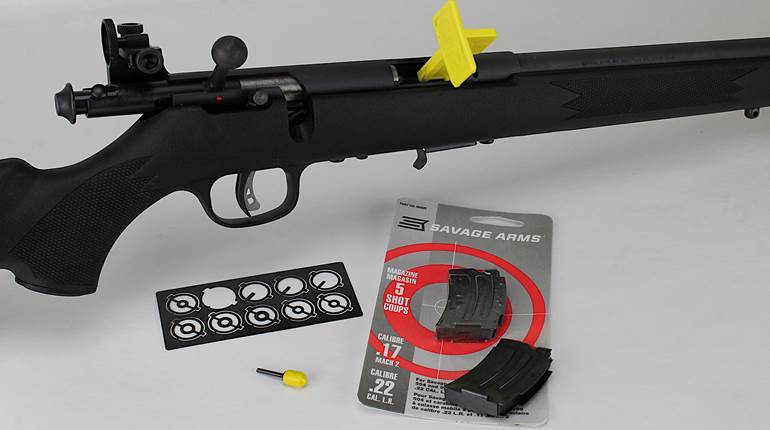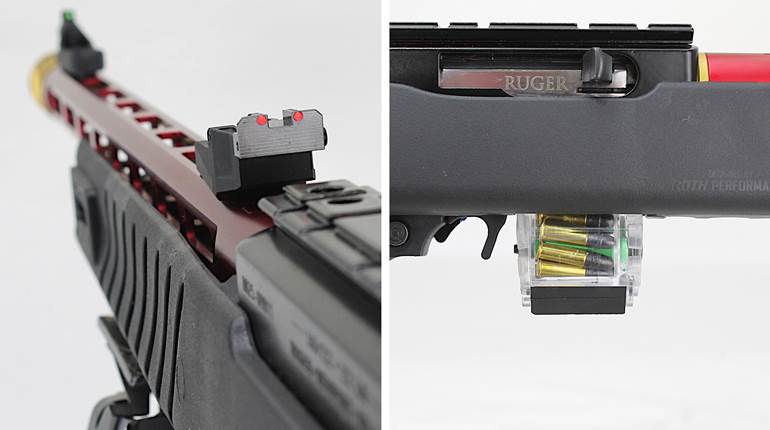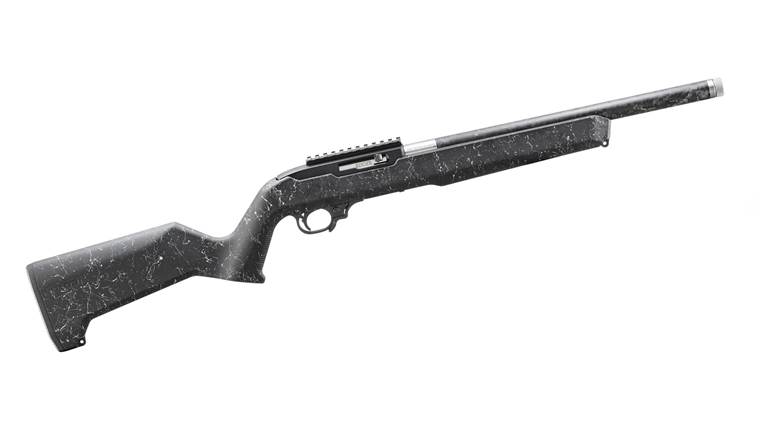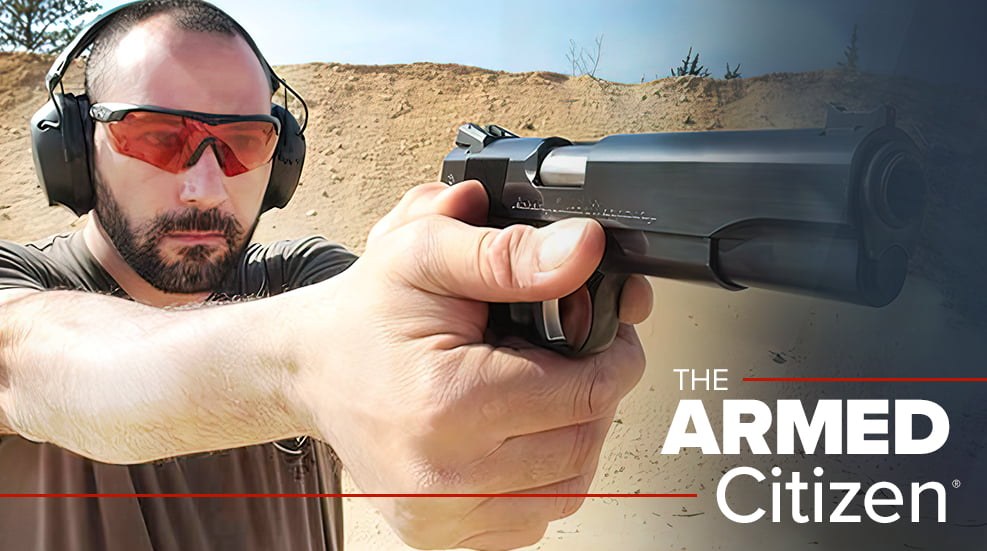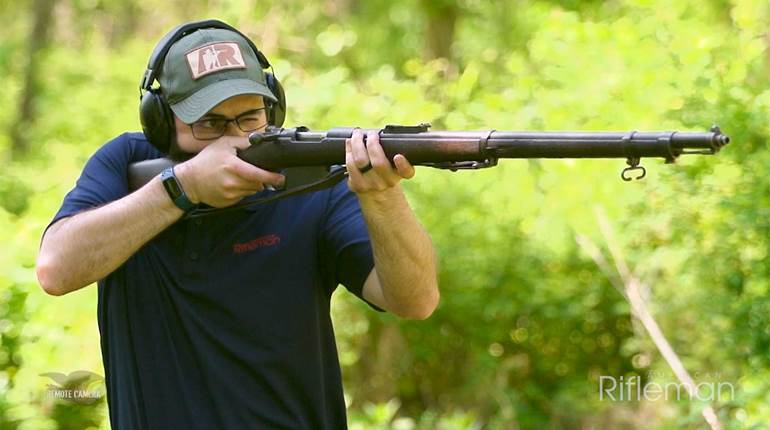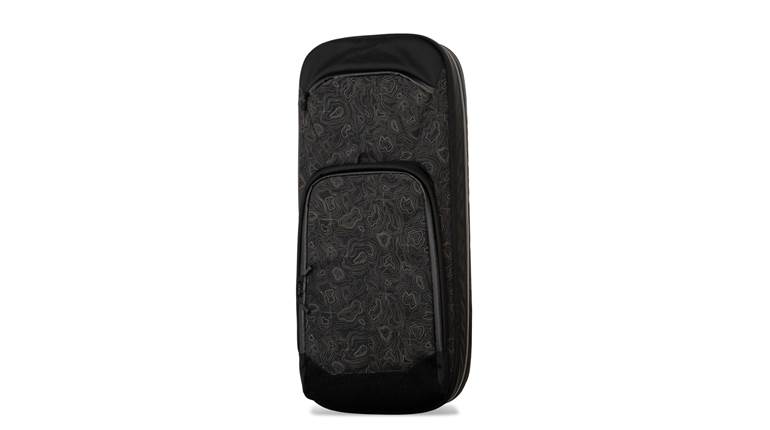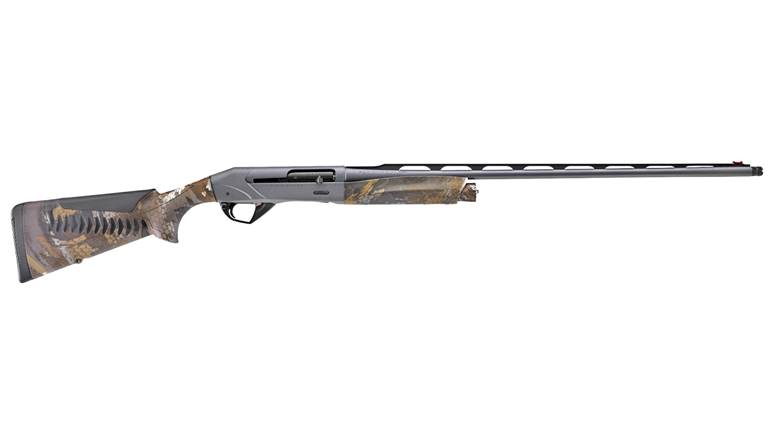
I’ll be frank, I didn’t see the Springfield Model 2020 Rimfire rifles coming. Nor had I seen the excellent centerfire Waypoint 2020 on the horizon. Usually I could win some Vegas odds guessing which category a company will enter. If Springfield were the house, it would have taken my lunch money and put me on a Greyhound back to Virginia. Although surprised, I could not be more pleased with both, especially the 2020 Rimfires.
After all, I am a huge fan of full-size .22 sporter rifles—ones that handle like centerfire hunting rifles but shoot affordable .22 Long Rifle ammunition. For practice in becoming a better rifleman, they can’t be beat. But there are also new sports emerging, such as the PRS Rimfire Series. And the 2020 Rimfire line, which ranges from the affordable to the extravagant, is extremely well-thought-out and capable of serving in all such roles.
According to Springfield Armory President Steve McKelvain, “The same strategy utilized in the development of the Model 2020 Waypoint centerfire continues to be highly successful, and we knew the same would hold true with a rimfire. We were aware there was no shortage of rimfire rifles on the market, but that didn’t prevent us from making room for this fun-to-shoot .22 LR bolt-action. By creating a feature set at a value, we knew shooting enthusiasts would have a place in their hearts, and in their collections, for this classic. The Model 2020 Rimfire is the perfect complement to our well-received centerfire line.”
In recent years, two other notable guns that combined adult sporter styling with walnut stocks were the Kimber Classic (June 2000, p. 42) and the Remington 504 (January 2004, p. 42), and I own both. They are among my favorite rifles, and with apologies to my friend Dwight Van Brunt, formerly of Kimber, the 504 outshoots any .22 I’ve ever owned. The Classic won the elegance contest, though. But, sadly, neither gun is made today, and both were expensive—they were American-made, after all. One likely reason is that neither offered the economy in price or scale of a synthetic-stock gun. If you wanted one, it was walnut, or sometimes laminate, or nothing. And the 504 employed perhaps one of the worst magazines in modern history, that of the Remington 597.
With the Model 2020 Rimfire rifles, Springfield has provided the solution to the issues that doomed my previous favorites. The gun was developed in partnership with—but to Springfield’s specifications by—Retay Arms Ltd. in Konya, Turkey. Retay was founded in 2006 and has made everything from starter pistols to shotguns imported under its own name. But it also makes these .22 LR rifles, which meshes well with Springfield’s history as both a domestic manufacturer and an importer—a business model that has served the modern firm for most of its existence. And just as a reminder that Turkish gunmaking has come a long way—particularly with shotguns, pistols and, now, rimfire rifles—other Turkish-made .22s include the Winchester Wildcat and Xpert. Modern plants with gleaming CNC machines have sprung up in several regions there, but compared to the United States or Europe, labor costs in Turkey remain considerably lower. That’s one benefit the 2020 Rimfires have, but not the only one.
“We knew if we created the right feature set with the right styling, it would be a home run for all those who love the nostalgia and pure joy of shooting a fine .22 bolt-action rifle,” McKelvain said. “The quality of the rifle’s workmanship only adds to the assurance for our customers that their money is well-spent.”
Choices, Choices
I’m no company president, nor even an investor, but I’m not sure I could have put it better. The gun speaks for itself in terms of the finish work on the metal. Most parts are matte blue, evenly applied, and I could find no tool marks or inconsistencies anywhere. Too, the synthetic stock on the version that serves as the main example for this story was well-executed. And the walnut? Well, we will get to that in a minute. Make no mistake, despite its price, the Springfield 2020 Rimfire is a quality gun.
Perhaps the best thing about this new model is that it is the basis for a line. The two synthetic-stocked Model 2020 Rimfire Target Rifles come with heavy target barrels threaded to accept suppressors. The sporter versions—called the Classic Models—come with walnut stocks and elegant, round bolt handles and the barrels have a tapered No. 2 contour. At present, there is no provision for attaching a suppressor to them.
I found the black Target to be the most interesting, and it is also the most affordable with a suggested retail price of $434, which is extremely competitive. There is also a “Sage W/Black Webbing” version in the Target line for $499. But, if walnut is your thing, you can spend pretty much as much as you would like on a Model 2020 Rimfire Classic. That makes sense, as just about all the world’s great walnut comes from Turkey these days, at least when it comes to gun stocks. The Classic is offered in four grades: Select Satin at $529; Grade A at $690; Grade AA at $839; and Grade AAA at $1,099. I’ve seen photos of the AAA, and they are magnificent.
Lock
Springfield knew that it could not have a good gun without a good magazine, and that there was no better mousetrap than the Ruger 10/22 rotary design dating from 1964. The flush-fitting, 10-round-capacity magazine is easy to load and probably the best-functioning .22 Long Rifle magazine ever devised. It’s certainly the most ubiquitous and can be upscaled in the form of the Ruger BX-15 or BX-25—for a round count of 15 or 25, respectively. I tried several factory Ruger 10/22 magazines, a BX-25 and three or four other 10/22-pattern magazines of undetermined origin; all worked flawlessly.

With the magazine issue solved, Springfield knew it would need a good trigger, because an adult rimfire is nothing without one. The single-stage 2020 trigger is based on that of the later Remington Model 700s, the ones with all the components sealed within a tamper-resistant housing. The trigger’s blade has a wide, smooth face and a deep bow. There was virtually no take-up or overtravel. It’s a nice trigger to be sure, adjustable down to a precise point, and pull weight can be changed by inserting a supplied hex wrench into the front face of the trigger group. The one on my test sample averaged 4 lbs., 6 ozs., across 10 measured pulls. There’s no provision to adjust the length, but its pull weight can be increased to 5 lbs., 8 ozs., without issue. I took it right back down to where it started for testing. Again, an excellent choice of a ubiquitous design in a key component. In fact, I knocked out the two pins holding the unit to the receiver and installed a favorite Timney trigger from one of my Model 700s, and it worked just fine.

The two-position safety, on the trigger assembly’s right, has a grooved lever that protrudes above the stock; it will be very familiar to Model 700 owners. A white dot is revealed when the trigger- and sear-blocking unit is in the rearward or safe position, and a red dot is visible on the stock when in the fire position. The bolt may be manipulated when the safety is engaged.
The rifle’s cylindrical steel receiver is 7 7⁄8" long and 1.17" in diameter and is topped by a supplied nine-slot, 5 3⁄8" Picatinny rail. The wood-stocked guns also have a provision for more elegant standard rings. Locking of the bolt is by way of a slot on the receiver’s right that engages the bolt’s handle. The bolt release—which engages a corresponding slot cut into the left side of the bolt to guide its travel—is in the receiver’s left rear. Depressing the release allows the bolt to be withdrawn; there is no need to pull the trigger to get the bolt out of the receiver.
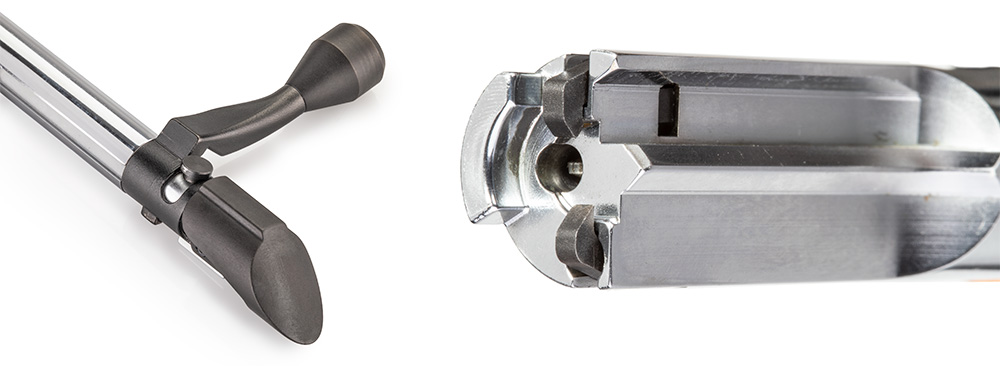
Chromed to reduce friction, the steel, cylindrical, 6.7"-long, 0.70"-diameter bolt body is machined of 4140 steel. There are dual extractors, really the left side one only holds the rim until the frame-mounted blade ejector can kick it out to the right through the generous ejection port. Moving rearward, there’s a lug or cocking cam on the top of the bolt that changes the geometry of the bolt’s operation, smoothing out its travel as the bolt is withdrawn 1.04". Most .22s have a 90-degree bolt throw, but because of the cam, the 2020 has a 60-degree throw. It is a clean, short stroke, and it’s incredibly easy to just stay in the scope; there’s no straining or slamming. The generously sized striker, too, is chromed and covered by a matte-blue shroud. The Target model’s bolt knob is shaped from the factory like many “tactical” or PRS handles, but it is threaded and can be replaced with your favorite knob.
Stock
The stock of the basic black Target version that I tested is molded of polymer, but it doesn’t have that hollow feel you get with some. Starting at the front, the fore-end is flat and wide on the bottom—to better ride sandbags—with stippling panels on either side. Its contour steps down at the receiver ring to make the stock around the receiver lighter and trimmer. There’s a generous pistol grip with bilateral palm swells with stippled panels on either side. The buttstock has a fairly high comb that tapers at both the top and the bottom; I had no trouble getting an excellent cheek weld. It is topped off by a rubber recoil pad that is removable, so spacers could extend the length of pull. That said, the length of pull comes in at 13½", so this is obviously a rifle intended for adults. Threaded holes for the action screws are at the receiver ring and just forward of the trigger. A third hole drilled in the receiver’s underside locates on a pin that extends upward from the stock.
The aluminum magazine release is located right in front of the trigger guard, and it is oversize as is often found on contemporary 10/22 upgrades. Pushing it forward pulls the locking stud on the magazine’s rear out of engagement. Magazines do not simply drop free—a recess at the magazine’s front allows a finger to pull the detachable box out of the rifle. The only steel parts on the stock that I could detect with my trusty magnet were the swing swivels—one at the front of the fore-end and one just ahead of the stock’s toe.
And Barrel
The free-floated, 20" heavy-contour barrel of the Target, which I subjected to the American Rifleman testing protocol for rimfires of 10-round groups, starts off at 0.75" at the muzzle behind the 1/2x28 TPI threads (covered by a supplied thread protector), and is 0.97" in diameter where it screws into the cylindrical receiver. Rifling is six-groove with a 1:16" right-hand twist. The Target’s barreled action weighs in at 4 lbs., 10 ozs., while the fully assembled rifle comes in at 7 lbs., 6 ozs.

The matte-blued-steel action is attached to the stock by way of through bolts at the aforementioned locations on the receiver ring and at the front of the trigger guard; there is no need for pillar bedding here as the one-piece aluminum trigger guard assembly carries out that role. It extends all the way to the front of the magazine, and the iconic Springfield American flag is tastefully etched into the bottom of its generous, squared trigger guard.
The Target model was fitted with a Banish 22 suppressor from Silencer Central for the groups you see in the accompanying table. The titanium, 5 3⁄8"-long suppressor threaded directly onto its 1/2x28 TPI muzzle. Interestingly, I suspect due to the profile of the barrel and the light weight of the silencer, there was no impact shift or discernible change in group size with the suppressor mounted, and it made my indoor range sessions more pleasant.
At The Range
For the accuracy test, the Model 2020 Rimfire Target was fired at 50 yards with five consecutive, 10-shot groups. That is our standard protocol for .22 rifles, and it is a tough bar. The guns come with a 1" accuracy guarantee for three shots with match ammunition at 50 yards. Piece of cake. Five shots would often form one hole, but 10-shot groups are different. I used a Leupold 3-9X 40 mm 1" riflescope set to 9X for the testing reported here, then fired some other groups, not reported, with the Model 2020 Classic in AA Grade walnut. Through three guns and more than 800 rounds of seven types of .22, there was only one failure to fire, and that was with a cartridge lacking priming compound in its rim, which is not the gun’s fault. That beefy striker set off everything that was going to fire.
Final Thoughts
The .22 rimfire rifle is America’s favorite. Premium adult bolt-action sporters have had a checkered past in recent memory, but all the reasons they didn’t succeed have been addressed by Springfield on the front end with the new Model 2020 Rimfires. These guns really shoot and, particularly as the grades of walnut ascend, they look fantastic. What’s more, no longer is the Remington 504 my most-accurate .22.

When it comes to buying the guns I test, it may amount to about one in 20—but this will not be one of those that got away. The introduction of guns that look this good and perform this well reminds me that I haven’t always been able to predict what will succeed and what won’t in that segment of the market—but I do know what I like, and I predict that a lot of other shooters who value .22 rifles are also going to discover that the Springfield Model 2020 Rimfire line is a pleasant surprise.












